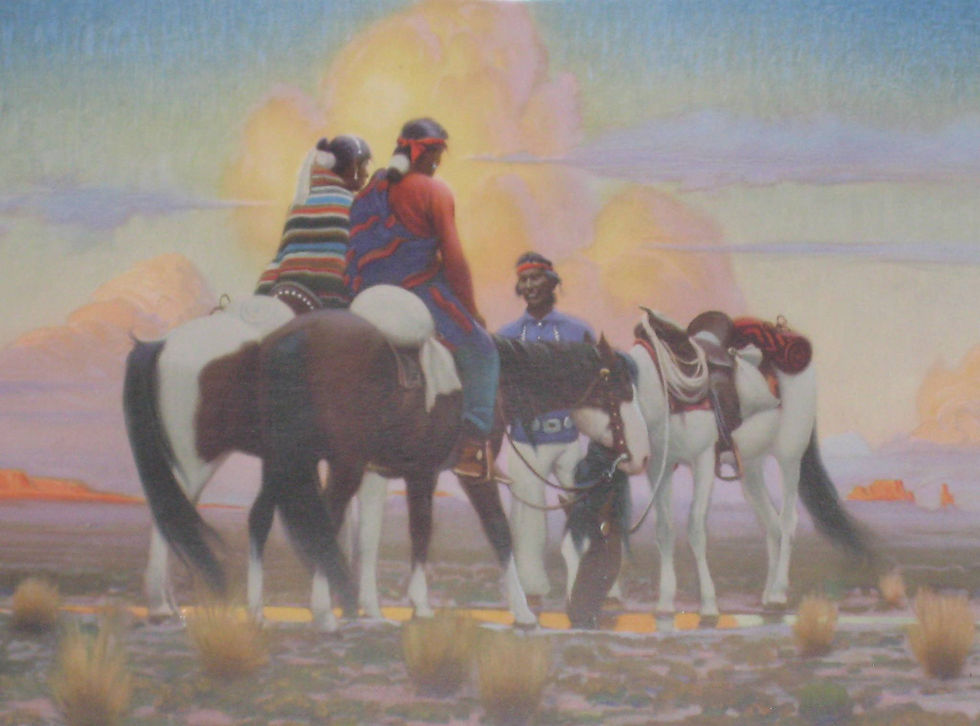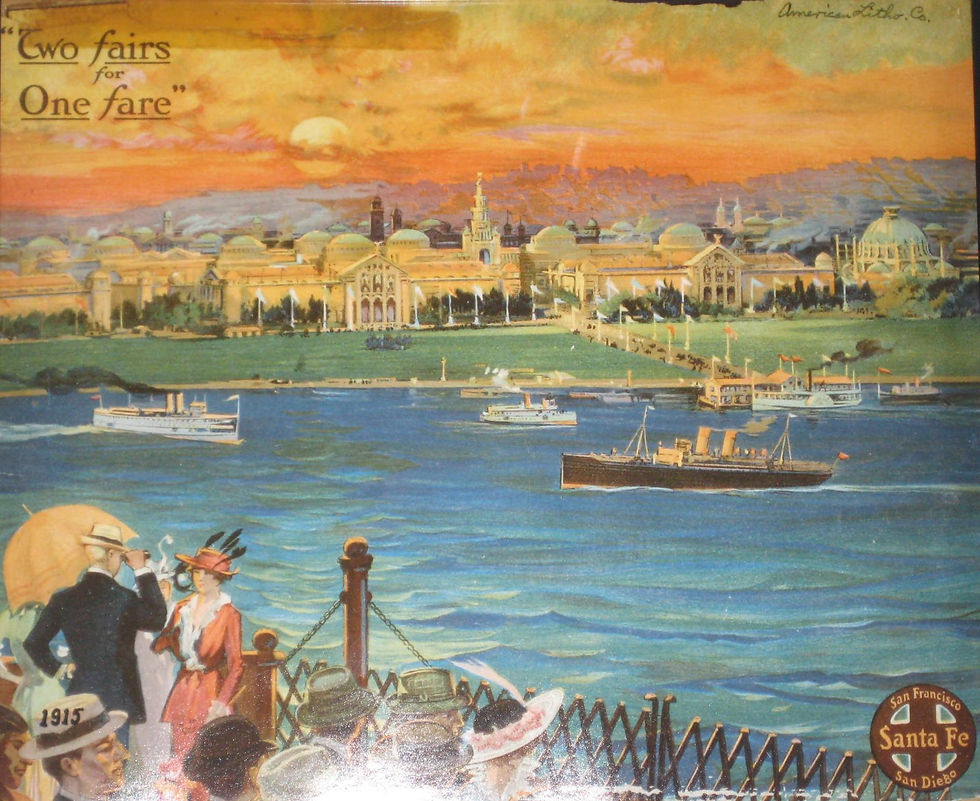top of page
New Exhibit: Honoring our Heroes Opening November 5th
SANTA FE CALENDAR EXHIBIT
On Loan from Harry Brisco This remarkable collection of calendar art features stunning views of the Southwest landscape and culture of the Native American Indians of the day. The art was commissioned by the Atchison , Topeka and Santa Fe Railway, to create their annual calendars which were distributed throughout the country. Harry Briscoe, former General Manager of the AT&SF Eastern Lines in Topeka acquired the collection many years ago and continued to add to it. The collection includes 84 calendars, beginning with the first in 1907 and ending with the last in 1993. A special addition is a display of the "Aztec Calendar" for January - June of 1900, a relatively unknown forerunner fo the traditional Santa Fe calendars. The calendars are now on display in the Fink Exhibit Gallery at the Great Overland Station through the end of the year.
The Art of the Santa Fe Calendars from 1907 - 1993
On loan from the collection of Harry J. Briscoe
This remarkable collection of calendar art, displayed high on the walls of the Fink Exhibit Gallery, features stunning views of the Southwest landscape and depictions of the culture of the Native American Indians of the day. The art was commissioned by the Atchison, Topeka and Santa Fe Railway for their annual calendars, which were distributed throughout the USA.
Why did the Santa Fe Railway create these calendars?
A great amount of credit for the calendars is given to W. H. Simpson, who established the Advertising Department of the AT&SF Railway in 1896. The railway wanted to grow its passenger service through the Southwest by appealing to tourists. They did so by representing the beauty of the country combined with the culture and ceremonial customs of the Native American tribes. Because color photography was not an option in that era, the railway naturally turned to artists for their renderings of the West. Many of the original pieces of art from which the calendars were produced are at the BNSF Railway offices in Fort Worth, TX.
About the collection
Harry J. Briscoe, former General Manager, AT&SF Eastern Lines, acquired a good portion of this collection from Joe Littrell of Iola, Kansas in the mid-1960’s. The calendars had been displayed on the walls of the passenger waiting room in Iola, but when his successor requested that they be removed, Mr. Littrell took them home. Following the meeting where Mr. Briscoe was speaking to the Santa Fe Telegraphers Union meeting in Iola, Mr. Littrell invited Mr. Briscoe to accompany him to his residence where he presented him with a number of boxes containing all his calendar illustrations. Mr. Briscoe had the entire collection cleaned and frames repaired. Mr. Briscoe and his wife, Mary Catherine, proudly displayed the collection in their home, adding new calendars until the Santa Fe ceased publication of the calendars in 1993.
About the collector:
Harry J. Briscoe began his career with the Santa Fe Railway on January 4, 1937, in Slaton, Texas. Beginning as a stenographer, he worked in various positions in such outposts as Oklahoma City, OK;Chicago, IL; Amarillo, TX; Waynoka, OK; La Junta, CO; Wellington, KS; Emporia, KS and San Bernardino,CA, before completing his 45-year career in Topeka as General Manager, Eastern Lines. Briscoe retired in 1982.
The Mystery of the Calendars of 1910 and 1911
The collection does not contain the calendars in 1910 and 1911; in fact, these calendars are not part of any identified collection as far as the Briscoe family knows. For many years, they were listed as “unknown” on the Santa Fe’s Railways listings. In the 1970’s an article discovered in a 1913 edition of the Santa Fe Magazine indicated the following:“…the 1910 calendar, as many no doubt will remember, was a facsimile of a piece of Indian pottery artistically colored in dull red, while the 1911 calendar was a lithographic reproduction of an Indian basket, different shades of brown predominating.”
The photos are probable representations of the 1910 and 1911 calendar photographs. Note the Santa Felogo on each of the pieces. It is currently unknown whether either of these calendars exists as an original.
Other Notes
1907 First calendar
1908 There is no record of a calendar in 1908.
1919, 1920 During World War I, the railroads were nationalized. As a result, no calendars were produced in those years.
1993 Final calendar
1990 Aztec Calendar, January – June 2000
The “Aztec Calendar” is a little-known forerunner to the more famous calendars distributed by the Atchison, Topekaand Santa Fe Railway from 1907 – 1993. The calendar was published as a set of six calendars – one for each monthJanuary through June – which was bound together by a simple strand looped through the two holes at the top of eachpage and tied in a knot. These pages were found among Harry Briscoe’s papers.
Permanent Exhibits
Santa Fe Artifacts and Photographs
Union Pacific Artifacts and Photographs
Display of Kansas trains dating back to 1932
History of Topeka from 1800 to present
Display of Harvey Houses and Harvey Girls
Photographs of Topeka Churches
Photographs of Education Buildings
Model G Gauge Train Layout
Photographs Flood of 1951 and 1966 Tornado
Simulator and Baggage Cart
This remarkable collection of calendar art features stunning views of the Southwest landscape and culture of the Native American Indians of the day. The art was commissioned by the Atchison , Topeka and Santa Fe Railway, to create their annual calendars which were distributed throughout the country. Harry Briscoe, former General Manager of the AT&SF Eastern Lines in Topeka acquired the collection many years ago and continued to add to it. The collection includes 84 calendars, beginning with the first in 1907 and ending with the last in 1993. A special addition is a display of the "Aztec Calendar" for January - June of 1900, a relatively unknown forerunner fo the traditional Santa Fe calendars. The calendars are now on display in the Fink Exhibit Gallery at the Great Overland Station through the end of the year.

KSLiving_01 exhibit Page.jpg

KSLiving_02.jpg

KSLiving_03.jpg

KSLiving_04.jpg

KSLiving_05.jpg

KSLiving_06.jpg

KSLiving_07.jpg

KSLiving_08.jpg

KSLiving_09.jpg
bottom of page
